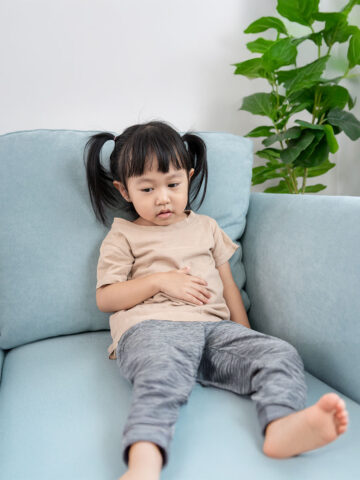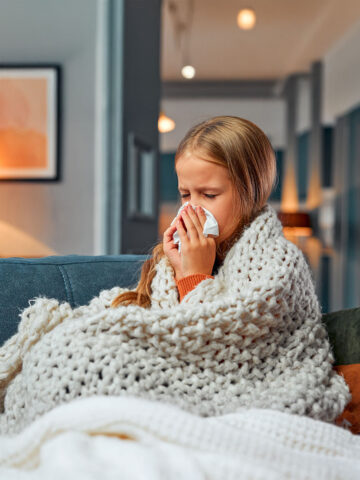Typically, most diaper rashes will clear up within two to three days with home care and simple changes in diapering and home care. Dr. Leila Iravani, a pediatrician in the CHOC Primary Care Network, recommends these four steps to help resolve diaper rash:
- Parents check their baby’s diaper often and change it as soon as it’s wet or soiled.
- Gently clean the diaper area with mild soap and water and pat dry.
- Creams and ointments containing zinc oxide or petroleum can help to soothe skin and protect it from moisture. Smear them on thickly at each diaper change.
- Letting a baby go without diapers for a few hours each day can help irritated skin dry and “breathe.” Try placing the baby in a crib with a waterproof sheet or on the floor atop a large towel.
When to call the pediatrician about diaper rash
It’s time to call the doctor if the baby’s rash doesn’t improve after five days, gets worse, or if sores appear on the baby’s skin, says Dr. Iravani. Seek medical care if the baby has a fever, pus drains from the rash area, or the baby is fussier than usual.
The doctor may take a few paths for treatment, depending on what type of rash the baby has. They may prescribe an antifungal cream or an antibiotic cream, or recommend other changes to the diapering routine. If the rash is caused by an allergic reaction, the doctor may prescribe a mild steroid cream.
Causes of diaper rash
Typically, one of four culprits is behind a diaper rash, says Dr. Iravani.
- Irritation can cause a diaper rash. A baby’s new, sensitive skin can get irritated when a diaper is left on for too long and waste, or the diaper itself, rubs against the skin repeatedly.
- Another cause is infection. Urine changes the skin’s pH levels, which can allow bacteria and fungi to grow more easily. Couple that with a warm, moist environment created by tight diapers with little air circulation, and bacteria and fungi have a perfect place to thrive. This can cause a rash.
A diaper rash that lasts more than a few days even with a change in a diapering routine can be caused by a yeast called Candida albicans. This rash is usually red, slightly raised, and has small red dots spreading beyond the main part of the rash. It often starts in the deep creases of skin and can spread to skin on the front and back of the baby. Antibiotics given to a baby or a nursing parent can cause this, as they eliminate “good” bacteria that keep Candida from growing. - Allergies can also trigger diaper rash. Some types of detergents, soaps, diapers or baby wipes can affect a baby’s sensitive skin, which can cause a rash.
- Diet can be a culprit behind diaper rash. Starting new foods can change the content and frequency of a baby’s waste, which can lead to diaper rash. A bout of diarrhea can make an existing flare up worse.
Preventing diaper rash
Keeping a baby’s skin as dry and clean as possible and changing diapers frequently are key to preventing diaper rash. Dr. Iravani recommends these measures:
- Change the baby’s soiled or wet diapers as soon as possible and clean the area well.
- Occasionally soak the baby’s bottom between diaper changes in warm water. Caregivers can gently scoop the water over the baby’s bottom with their hand or squeeze it from a plastic bottle.
- Let the baby’s skin dry completely before putting on another diaper.
- Pat the skin gently with a soft cloth when drying it — rubbing can irritate skin.
- Put the diaper on loosely to prevent chafing.
- Change diapers often — ideally every two hours or so — and after every poop.
- Applying diaper cream or ointment with each diaper change can help some babies with sensitive skin, but not all babies need this.
Parents who use cloth diapers should check the manufacturer’s directions on how to best clean them. Dr. Iravani cautions to use only the amount of detergent recommended and to run an extra rinse cycle to remove any remaining traces of the detergent. Fabric softeners and dryer sheets can also irritate a baby’s skin, Dr. Iravani says.
If using disposable diapers, parents of babies with sensitive skin might consider diapers without fragrance or dyes. Also, water and a washcloth might be a gentler option for babies very sensitive to baby wipes, Dr. Iravani says.
For more health and wellness resources from the pediatric experts at CHOC, sign up for the Kids Health newsletter.
Find a CHOC Primary Care Pediatrician
From babies to teens, pediatricians from CHOC’s Primary Care Network partner with parents to offer immunizations, sick visits, sports physicals and more.





